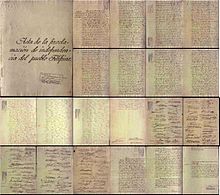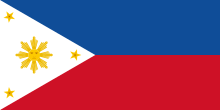Philippine Declaration of Independence
This article needs additional citations for verification. (June 2010) |
| Philippine Declaration of Independence | |
|---|---|
 Official draft copy of the Declaration of Independence | |
| Created | May–June 1898 |
| Presented | June 12, 1898, in Cavite el Viejo, Cavite |
| Ratified | August 1, 1898 (first ratification in Bacoor, Cavite) September 29, 1898 (official ratification by the Malolos Congress) |
| Location | National Library of the Philippines[1] |
| Commissioned by | Dictator Emilio Aguinaldo |
| Author(s) | Ambrosio Rianzares Bautista |
| Signatories | 98 delegates |
| Purpose | To proclaim the sovereignty and independence of the Philippines from the colonial rule of the Spanish Empire |
The Philippine Declaration of Independence (Filipino: Pagpapahayag ng Kasarinlan ng Pilipinas; Spanish: Declaración de Independencia de Filipinas)[a] was proclaimed by Filipino revolutionary forces general Emilio Aguinaldo on June 12, 1898, in Cavite el Viejo (present-day Kawit, Cavite), Philippines. It asserted the sovereignty and independence of the Philippine islands from the 300 years of colonial rule from Spain.

History
[edit]In 1896, the Philippine Revolution began. In December 1897, the Spanish government and the revolutionaries signed a truce, the Pact of Biak-na-Bato, requiring that the Spanish pay the revolutionaries $MXN800,000[b] and that Aguinaldo and other leaders go into exile in Hong Kong. In April 1898, shortly after the beginning of the Spanish–American War, Commodore George Dewey, aboard the USS Olympia, sailed into Manila Bay, leading the Asiatic Squadron of the U.S. Navy. On May 1, 1898, the United States defeated the Spanish in the Battle of Manila Bay. Emilio Aguinaldo decided to return to the Philippines to help American forces defeat the Spaniards. The U.S. Navy agreed to transport him back aboard the USS McCulloch, and on May 19, he arrived in Cavite.[3]
The Proclamation on June 12
[edit]

Independence was proclaimed on June 12, 1898, between four and five in the afternoon in Cavite at the ancestral home of General Emilio Aguinaldo in Cavite el Viejo (present-day Kawit), Cavite, some 30 kilometers (19 mi) south of Manila. The event saw the unfurling of the flag of the Philippines, made in Hong Kong by Marcela Agoncillo, Lorenza Agoncillo, and Delfina Herboza, and the performance of the Marcha Filipina Magdalo, as the national anthem, now known as Lupang Hinirang, which was composed by Julián Felipe and played by the San Francisco de Malabon marching band.
The Act of the Declaration of Independence was prepared, written, and read by Ambrosio Rianzares Bautista in Spanish.[4] The Declaration was signed by 98 people,[5] among them a United States Army officer who witnessed the proclamation. The final paragraph states that there was a "stranger" (stranger in English translation—extranjero in the original Spanish, meaning foreigner) who attended the proceedings, Mr. L. M. Johnson, described as "a citizen of the U.S.A., a Colonel of Artillery".[6] Despite his prior military experience, Johnson had no official role in the Philippines.[7] The only copy of the "Acta de la Proclamacion de Independencia del Pueblo Filipino" or "The Birth Certificate of the Filipino Nation", handwritten by Lt. Col. Jose Bañuelo, was sold for P11.4 million at the Leon Gallery auction on September 14, 2024.[8][9]
Ratification
[edit]The proclamation of Philippine independence was only promulgated on August 1, when many towns had already been organized under the rules laid down by the Dictatorial Government of General Aguinaldo.[10][11] There were 190 municipal presidents from different towns in 16 provinces—Manila, Cavite, Laguna, Batangas, Bulacan, Bataan, Infanta, Morong, Tayabas, Pampanga, Pangasinan, Mindoro, Nueva Ecija, Tarlac, La Union, and Zambales—who ratified the Proclamation of Independence in Bacoor, Cavite.
Later, at Malolos, Bulacan, the Malolos Congress modified the declaration upon the insistence of Apolinario Mabini, who objected to the original proclamation, which essentially placed the Philippines under the protection of the United States.
Struggle for independence
[edit]The declaration was never recognized by either the United States or Spain. Instead, Spain ceded the Philippines to the United States in the 1898 Treaty of Paris, which ended the Spanish–American War.
The Philippine Revolutionary Government did not recognize the treaty or American sovereignty and subsequently fought and lost a conflict with the United States originally referred to by the Americans as the "Philippine Insurrection" but now generally and officially called the Philippine–American War. Emilio Aguinaldo was captured by U.S. forces on March 23, 1901,[12][failed verification][dead link] and issued a statement acknowledging and accepting the sovereignty of the United States over the Philippines.[13][failed verification][dead link] On July 2, 1902, U.S. Secretary of War Elihu Root telegraphed that the Filipino insurrection had come to an end, and provincial civil governments had been established everywhere except those areas inhabited by Moro tribes.[14] Pockets of resistance continued for several years.
Following the end of World War II, the United States granted independence to the Philippines on July 4, 1946, via the Treaty of Manila.[15] July 4 was observed in the Philippines as Independence Day until August 4, 1964, when, upon the advice of historians and the urging of nationalists, President Diosdado Macapagal signed into law Republic Act No. 4166, designating June 12 as the country's Independence Day.[16] June 12 was previously observed as Flag Day, and many government buildings are urged to display the Philippine Flag in their offices.
Current location of the Declaration
[edit]The Declaration is currently housed in the National Library of the Philippines.[1] It is not on public display, but like any other document held by the National Library, it can be viewed with permission.
During the Philippine–American War, the American government captured and sent to the United States about 400,000 historical documents.[17] In 1958, the documents were given to the Philippine government along with two sets of microfilm of the entire collection, with the U.S. Federal Government keeping one set.[17]
The Declaration was stolen from the National Library sometime in the 1980s or 1990s.[1] As part of a larger investigation into the widespread theft of historical documents and a subsequent public appeal for the return of stolen documents, the Declaration was returned to the National Library in 1994 by historian and University of the Philippines professor Milagros Guerrero, who mediated the return of the documents.[17]
The text of the "Act of the Proclamation of Independence of the Filipino People"
[edit]This section needs expansion. You can help by adding to it. (June 2012) |
The Act of the Proclamation of Independence of the Filipino People (Spanish: Acta de la proclamación de independencia del pueblo Filipino; Filipino: Katitikan ng Pagpapahayag ng Kasarinlan ng Sambayanang Pilipino) is part of a long line of declarations of independence, including the United States Declaration of Independence. It includes a list of grievances against the Spanish government stretching back to Ferdinand Magellan's arrival in 1521. It confers upon "our famous Dictator Don Emilio Aguinaldo all the powers necessary to enable him to discharge the duties of Government, including the prerogatives of granting pardon and amnesty."[18]
See also
[edit]Notes
[edit]- ^ Full name: Act of the Proclamation of Independence of the Filipino People (Filipino: Kasulatan ng Pagpapahayag ng Kasarinlan ng Sambayanang Pilipino; Spanish: Acta de la proclamación de independencia del pueblo Filipino)
- ^ The Mexican dollar at the time was worth about 50 US cents, equivalent to about $18.31 today.[2] The peso fuerte and the Mexican dollar were interchangeable at par.
- ^ a b c Rufo, Aries (May 26, 2008). "Court set to decide on National Library pilferage of historical documents". Abs-cbnNEWS.com/Newsbreak. Retrieved January 29, 2013.
Around 8,183 documents, mostly classified as Philippine Revolutionary Papers, were returned to the National Library. One University of the Philippines professor returned more than 6,000 documents. Among the retrieved documents were the manuscript of Andres Bonifacio's trial, the Declaration of Independence, the Pact of Biac-na-Bato and Leonor Rivera's letter to Rizal's parents dated Dec. 10,1893.
- ^ *Halstead, Murat (1898). "XII. The American Army in Manila". The Story of the Philippines and Our New Possessions (published May 22, 2004). p. 126..
- ^ Agoncillo, page 157
- ^ Sagmit, E.A. The Filipino Moving Onward 5' 2007 Ed. Rex Bookstore, Inc. p. 162. ISBN 978-971-23-4154-0.
- ^ Environment, United States. Congress. House. Committee on Foreign Affairs. Subcommittee on Asia, the Pacific, and the Global (2009). Honoring the 111th Anniversary of the Independence of the Philippines: Markup Before the Subcommittee on Asia, the Pacific, and the Global Environment of the Committee on Foreign Affairs, House of Representatives, One Hundred Eleventh Congress, First Session, on H. Con. Res. 153, October 14, 2009. U.S. Government Printing Office. p. 5. ISBN 978-0-16-084875-9.
{{cite book}}: CS1 maint: multiple names: authors list (link) - ^ Dean Conant Worcester, in his 1914 book The Philippines: Past and Present (Worcester 1914), says:
- "Invitations to the ceremony of the declaration of independence were sent to Admiral Dewey; but neither he nor any of his officers were present. It was, however, important to Aguinaldo that some American should be there whom the assembled people would consider a representative of the United States. 'Colonel' Johnson, ex-hotel keeper of Shanghai, who was in the Philippines exhibiting a cinematograph, kindly consented to appear on this occasion as Aguinaldo's Chief of Artillery and the representative of the North American nation. His name does not appear subsequently among the papers of Aguinaldo. It is possible that his position as a colonel and chief of artillery was a merely temporary one which enabled him to appear in a uniform which would befit the character of the representative of a great people upon so solemn an occasion!"
- ^ Bradford, James C. (2016). America, Sea Power, and the World. John Wiley & Sons. p. 150. ISBN 9781118927922.
- ^ Yap, Jade (September 11, 2024). "How Leon Gallery got a hold of the copy of declaration of Philippine independence for auction". GMA Network. Retrieved September 11, 2024.
- ^ Nakpil, Lisa Guerrero (September 17, 2024). "Copy of declaration of Philippines independence sold for P11.4 million". The Philippine Star. Retrieved September 18, 2024.
- ^ Guevara, Sulpicio, ed. (1972), "Philippine Declaration of Independence", The Laws of the First Philippine Republic (The Laws of Malolos) 1898-1899., Manila: National Historical Commission, retrieved March 26, 2008. (English translation by Sulpicio Guevara)
- ^ Guevara, Sulpicio, ed. (1972), "Facsimile of the Proclamation of the Philippine Independence at Kawit, Cavite, June 12, 1898", The Laws of the First Philippine Republic (The Laws of Malolos) 1898-1899., Manila: National Historical Commission, retrieved March 26, 2008. (Original handwritten Spanish)
- ^ Worcester 1914, p. 175
- ^ Worcester 1914, pp. http://en.wiki.x.io/wiki/Cession175–176
- ^ Worcester 1914, p. 293
- ^ TREATY OF GENERAL RELATIONS BETWEEN THE UNITED STATES OF AMERICA AND THE REPUBLIC OF THE PHILIPPINES. SIGNED AT MANILA, ON 4 JULY 1946 (PDF), United Nations, archived from the original (PDF) on March 26, 2009, retrieved December 10, 2007
- ^ REPUBLIC ACT NO. 4166 - AN ACT CHANGING THE DATE OF PHILIPPINE INDEPENDENCE DAY FROM JULY FOUR TO JUNE TWELVE, AND DECLARING JULY FOUR AS PHILIPPINE REPUBLIC DAY, FURTHER AMENDING FOR PURPOSE SECTION TWENTY-NINE OF THE REVISED ADMINISTRATIVE CODE, Chanrobles law library, August 4, 1964, retrieved June 11, 2008
- ^ a b c "Asiaweek". CNN. August 31, 1999. Archived from the original on February 15, 2013. Retrieved January 29, 2013.
- ^ Wikisource:Philippine Declaration of Independence
References
[edit]- History of the Filipino People. Teodoro A. Agoncillo
- National Library of the Philippines
- Philippine History Group of Los Angeles
- Worcester, Dean Conant (1914), The Philippines: Past and Present (vol. 1 of 2), Macmillan, retrieved January 17, 2008
